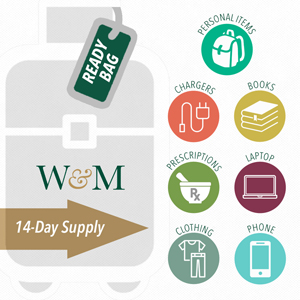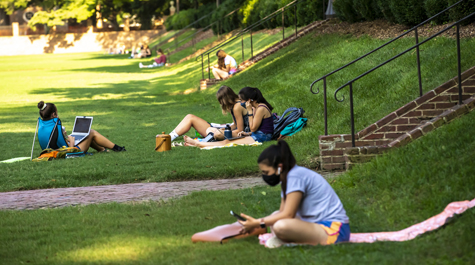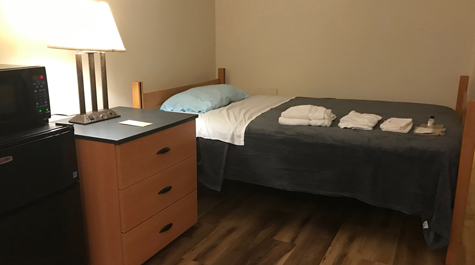W&M has plan to manage, mitigate impacts of possible positive COVID-19 cases
Protecting the safety and health of the university and surrounding communities is a top goal at William & Mary, as students and employees are required to wear masks and maintain proper physical distancing as outlined in the Healthy Together Community Commitment. The university also has a plan to manage and mitigate the impacts of any positive cases.
“We know we’re going to have positive cases, but what we want to be able to do is identify them quickly and separate them from their peers quickly,” said Dr. David Dafashy, medical director at the Student Health Center.
“We know students are not at a high risk for complications from this virus. They’re not going to get terribly ill, but the likelihood of it spreading is great because so many of them aren’t going to have symptoms whatsoever. So the very fact that this is not a particularly virulent virus in the 18-to-22-year old age group is exactly what makes it a rather dangerous virus for those that are at a higher risk.”
{{youtube:medium:right|bk1Otn6upP4, Identification and quick separation}}
Many new students arrived on campus a few weeks back, and upperclassmen will return during the Labor Day weekend in advance of the start of in-person undergraduate classes Sept. 8.
Prior to students arriving, W&M established a COVID-19 testing program that exceeds state health and CDC guidelines and is designed to be responsive to the most at-risk populations within the community.
These testing protocols include mandatory screening of students before they arrive on campus and prevalence testing among students and employees to track campus trends relative to those locally, within Virginia and nationally.
Prevalence testing of students and employees began August 25 and results are posted daily to W&M’s public dashboard.
On Sept. 4, the university announced that all students who will be on campus this fall will undergo a required second round of testing, administered on-site. More information will be provided next week. W&M may also introduce additional testing tools, such as waste-water testing, as they become available.
Moreover, the university has the capability to administer rapid tests to students who show symptoms or have been exposed to COVID-19.
These testing methods will allow W&M to move swiftly in the event positive cases occur within the university community.
“I think by continuing to do surveillance testing at the rate that we’re planning on doing, and because the health center is going to be able to determine symptomatic cases very rapidly with the rapid antigen test, we're going to find ourselves better equipped to remove infected individuals from the population rather swiftly,” Dafashy said. “To me, that is what is going to create an environment that has this under control.”
Prevention is key
During recent walks on campus, Dafashy has been encouraged by what he has seen from students and employees in regards to preventative measures and physical distancing. That, he says, will remain the most important factor in managing positive cases on campus as more students arrive for the fall semester.
“Recently when I have walked around campus, I have to say I’ve been so impressed by the way students and faculty and staff are wearing masks appropriately and maintaining physical space, because those primary preventions are going to be what prevent an outbreak,” Dafashy said.
{{youtube:medium:right|OeyxrOw6UiQ, Minimizing close contacts}}
When positive COVID-19 cases arise, William & Mary has a plan in place to isolate those sick students from the rest of the university community. It also has a plan for quarantining students who have had sustained exposure to the disease, which the CDC defines as being within 6 feet of an infected person for a total of 15 minutes or more over a 24-hour period.
Students who experience symptoms are urged to make an appointment with the Student Health Center for a clinical assessment and testing if necessary. In the event of a positive test, students will be required to isolate for 10 days and must be without symptoms for the last 24 hours before they are cleared to return to campus.
Through contact tracing, other students known to have had sustained contact with an infected person may be required to quarantine for 14 days.
For students who live on campus, that isolation and quarantine will take place at Richmond Hall, a 100-room residence hall that has been outfitted to house students with COVID-19 and those who have been exposed to the disease.
Students who live off campus will be required to isolate or quarantine in place in their homes or apartments.
Students will also have the option of returning to their permanent homes with family to receive care or complete their isolation or quarantine.
Remote access to classes and/or classwork will be made available to all students in isolation and quarantine.
“Richmond Hall is ideal because of the setup of the space,” said Teresa Belback, director of Environmental Health & Safety. “For simplicity sake, it allows students to reside there without shared resources like restrooms and kitchens, and then we are able to readily service them with food and other items just by leaving it outside their door and not having to enter their space and have contact with them.”
Richmond Hall: Clean, safe housing
Richmond Hall was selected for isolation and quarantine because it offers the individual air handling system in each room necessary for the cleanest and safest housing, and it also provides bathrooms for each room, thereby eliminating common areas for occupants. It was available for use starting Aug. 12, the first day of First-Year Move-In.
The rooms at Richmond Hall have beds already made and bath linens placed at the foot of the bed. Many essentials, such as bars of soap, a mini-refrigerator, microwave and trash cans with extra liners will be in every room. University WiFi is in place to allow students in isolation and quarantine the ability to attend classes remotely.
Meal deliveries from Dining Services will occur twice daily, once for lunch and again with that day’s dinner and the next morning’s breakfast. An on-site pantry containing drinks, frozen and shelf stable food and other sundries is also available to students.
Support staff at Richmond Hall will be available to assist students during their stays. Staff are required to wear personal protective equipment at all times.
“One of the most important things to know is that quarantine and isolation housing is supported 24/7,” said Mariellynn Maurer, director of W&M Conference & Event Services. “We are here from 9 a.m. to 9 p.m., but we are on call from 9 p.m. to 9 a.m.
“Our main purpose and daily task is to be here to support them and make them as comfortable as possible during a time that might be uncomfortable for them.”
Students should to bring a “ready bag” with them to include personal items, such as books, laptop, phone, chargers, prescriptions and clothing to last up to 14 days. 
“We're actually informing people who make appointments here at the Student Health Center of the possibility of not going back to their dorm, so they should bring a bag including items they will need in isolation or quarantine,” Dafashy said.
William & Mary will have a physician on call 24 hours a day in charge of getting students checked into Richmond Hall in the event they receive a positive test or are informed of contact with an infected person. Medical care will be provided to students at Richmond Hall as deemed necessary.
“We will call everybody who has COVID-19 Monday through Friday to ask about symptoms or any concerns and to give medical advice,” Dafashy said. “The students will have access to a nurse line and an on-call physician during the weekend if they have any kind of emergent issues or medical questions.”
Rooms will be fully sanitized using the decontamination protocols put in place by Environmental Health & Safety after each use.
While at Richmond Hall, as part of the university’s Healthy Together Community Commitment and the ongoing effort to safeguard the overall health of the community, students will be restricted to their rooms whether they are in quarantine or isolation.
Common areas, offices and entranceways at Richmond Hall will be sanitized multiple times a day. Richmond Hall’s single gated entrance will be locked to all but very limited university personnel, including medical and cleaning staff.
All outside deliveries will be made at the front of the building away from the rooms. Each room will have an outside receptacle for Richmond Hall staff to make touchless door-to-door deliveries.
“We've got a lot of administrative controls in place for our own staff to be distanced and not have direct contact with anybody who’s here, but also we want to keep the public away from them too,” Maurer said.
High level of disinfection
Students and employees who test positive for COVID-19 are asked to visit ReportCOVID.wm.edu as soon as possible to initiate case management that will help them navigate living, study and work after a positive test result, while protecting their privacy.
These persons will receive instructions from a William & Mary physician or nurse and plans will be made for on-campus students to isolate for 10 days. Moreover, Environmental Health & Safety will quickly identify locations the student has been for cleaning and disinfecting purposes.
“If the person has been on campus, we have them identify their dorm room or office if they are an employee. We identify that location and areas that they might have impacted, such as the restroom and kitchen they use,” Belback said.
“And depending on the accessibility of the area, if we can restrict access and allow additional time, like 72 hours, then our custodians will enter the space and will do a high level of disinfection. If the space needs to be accessed immediately, our current protocol is that we will disinfect using electrostatic sprayers and disinfectant, which typically allows the area to be reoccupied within an hour after treatment.”
W&M purchased electrostatic sprayers to disinfect large areas and has introduced a series of chemicals – Vital Oxide, Virex Tb and Spectra 410 – that are registered by the EPA as effective against SARS-CoV-2, the virus that causes the disease COVID-19.
The university’s facilities management cleans and disinfects high-contact areas in classrooms and public spaces on an accelerated schedule, consistent with CDC guidelines. Moreover, the university has installed hand sanitation stations across campus, touch-free technology payments in dining halls, touchless temperature check kiosks and new signage to explain new health protocols.
Cleaning and disinfecting is done in tandem by the university’s custodial staff. Custodial workers are assigned areas on campus to monitor throughout the day, wiping down and disinfecting frequently touched surfaces.
Custodial workers are required to wear personal protective equipment at all times. Staff are provided gloves, masks and face shields and have undergone mandatory health and safety training. All frontline custodial staff have been tested for COVID-19.
Belback says these preemptive measures, along with students and employees wearing masks, adhering to physical distancing protocols and abiding by good hand hygiene, are the best defense in protecting campus from an outbreak.
“We've put a lot of controls in place that will reduce the risk of contracting this and we need everyone to adhere to those requirements, and when they do, it makes a significant difference,” Belback said. “And when they don't follow those requirements, such as the distancing and wearing a mask, they are not only increasing their risk, but the risk of others that they're interacting with.”
 Skip to main content
Skip to main content


